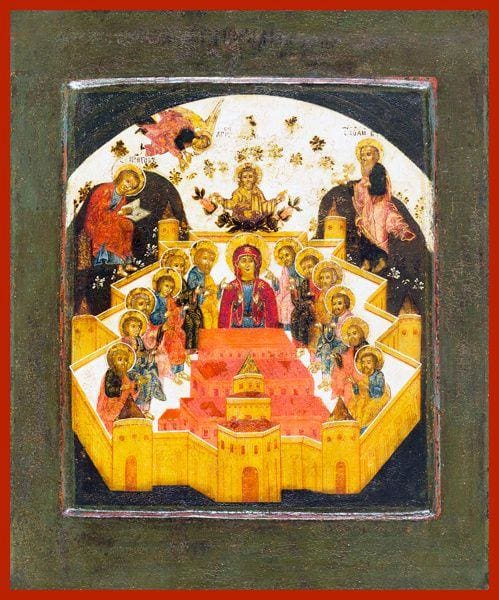
So [the angel] carried me away in the spirit … and showed me the holy city Jerusalem coming down out of heaven from God, possessing the glory of God. It had the radiance of a precious jewel…. (Apoc. 21:10-11)
The new heaven and the new earth are complete when the new Jerusalem descends from God. The city is described as being in a constant state of descending; it is always “coming down.” It is not static. It is always arriving. This movement indicates the city itself is alive. It is itself the Temple of the new heaven and new earth and therefore encapsulates the new creation which is intensely alive, just as the Temple built by Solomon was thought to encapsulate the world–the old world which, although it was currently alive, was always in the process of dying. The new Jerusalem is always coming down, always new, always becoming.
The new city has twelve foundation stones. Each is a precious jewel. These twelve stones are associated with the apostles, the Twelve; in Ephesians we read about the Church “built on the foundation of the apostles and prophets, Christ Jesus being himself the chief cornerstone.” (Eph. 2:20) If Peter is the rock (Matt. 16:17-19), the Twelve are the foundation.
The new city has twelve gates. Each gate is fashioned from pearl. Pearls in the ancient world were thought to be the result of lightning striking an oyster; the translucent pearl was born of fire and water, uniting these two opposite elements.
In Genesis 2, we are told that gold and jewels were found near the river Pishon. Often translated as “aromatic resin” or “pearls,” as well as “carbuncle” (a generic term meaning “a small, precious stone”), this is generally understood to refer to frankincense. (Frankincense was a particular resin/incense whose import and sale was a monopoly of the Franks in early medieval Europe, hence “the Frank’s incense.”) The resin was obtained by scoring—making slices in—the bark of certain trees. Sap would ooze from these wounds in the bark and congeal into the resin which would be scraped away and then these chunks of resin would be broken up to be used as incense. When the resin is sprinkled on hot charcoal, it melts and releases the fragrant smoke. The resins from various sorts of trees would produce a variety of fragrances which could be combined in different mixtures; myrrh, an especially bitter scent, was obtained in the same manner as frankincense but from another species of tree.
The particles of frankincense are customarily referred to as “pearls,” so that identifying Havilah–the land watered by the river Pishon–as the source of both frankincense and pearls is not necessarily a contradiction. There is also the later medieval Christian association of the round, white host at the Mass as a “pearl” as well as the eastern Christian practice of referring to the communion-particle as a “coal” (similar to the coal used by the seraphim to touch Isaiah’s lips to purify the prophet).
The jewels, pearls, and incense associated with the new city underscore its role as the temple of the new creation, the house of God in which the sacrificial worship of the Lamb is consummated.
There is a “New Jerusalem” monastery in Russia, built directly north of Jerusalem and an exact imitation of the church of the Holy Sepulchre for pilgrims who could not travel to the Middle East. It was closed by the communists and heavily damaged by the Nazis. I saw it in the early 1990s when it was still in ruins before the current restoration began.
